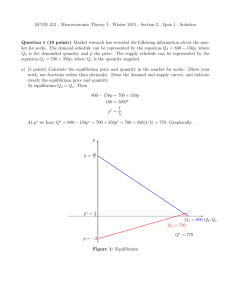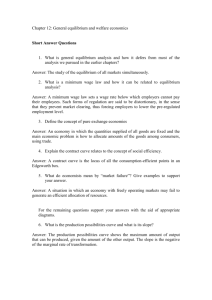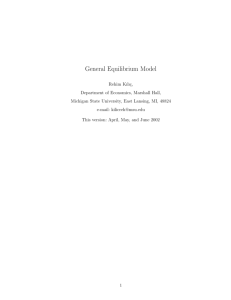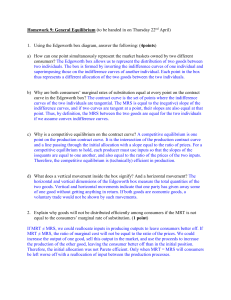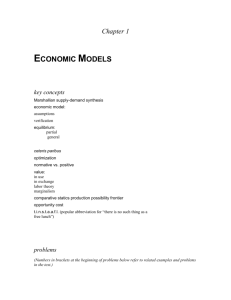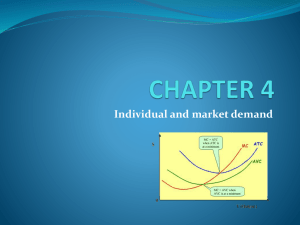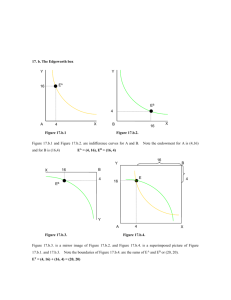Lecture 9: Welfare
advertisement
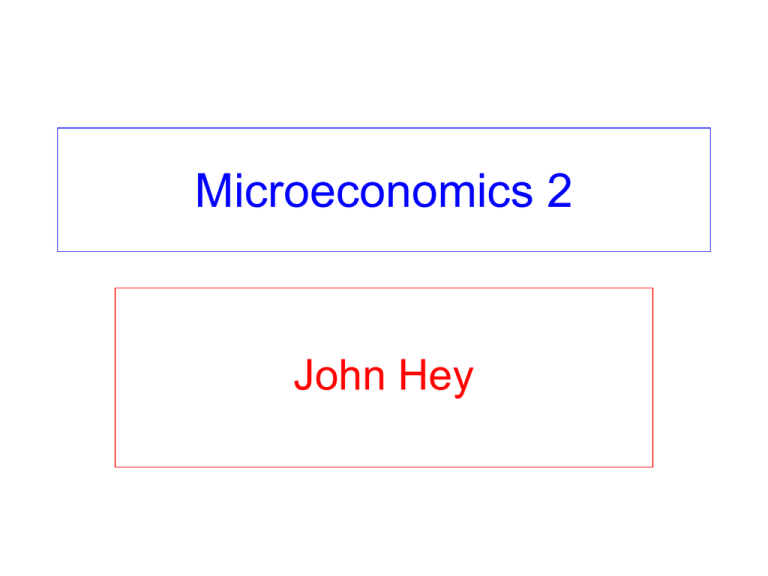
Microeconomics 2 John Hey Lecture 9 • Today I am going to start by reviewing the main points from Chapter/Lecture 8 ... • ... which I regard as the most important lecture/chapter of the module. • And then I will look at Chapter/Lecture 9... • ... which I think says essentially... • ... nothing. Summary of Chapter 8 • The contract curve - the locus of tangency points of the individuals’ indifference curves - shows the allocations that are efficient in the sense of Pareto. • There always exist the possibility of mutually advantageous exchange if preferences are different and/or endowments are different (unless the endowment point is on the contract curve). • Perfect competitive equilibrium (with both individuals taking the price as given) always leads to a Pareto efficient allocation. • If one of the individuals chooses the price the allocation is usually not Pareto efficient (monopoly/monopsony – undesirable for inefficiency). The contract curve • The contract curve shows the allocations that are efficient in the sense of Pareto. • If a point is off the contract curve then there is always some other point on the contract curve that is better for both individuals. • If a point is on the contract curve, then any movement away from that point is bound to make at least one of the two individuals worse off. • (Some slight qualifications to these results might be needed if the indifference curves are not smoothly convex everywhere.) Perfect competition equilibrium • Perfect competitive equilibrium (with both individuals taking the price as given) always leads to a Pareto efficient allocation. • Why? • Because at that equilibrium the price line must be tangential to the (highest possible) indifference curves for both individuals. • Hence at that equilibrium the indifference curves must be tangential... • ...and hence the equilibrium must be on the contract curve. The competitive equilibrium depends on the preferences and the endowments • If one individual changes his or her preferences in such a way that he or she now prefers more a particular good than before... • ... the relative price of that good rises. • If an individual is endowed with more of a good than before... • ... the relative price of that good falls. Scenario 2: B likes good 1 less than before hence equilibrium price of good 2 rises Scenario 3: both individuals have the same taste Scenario 6: each individual starts with just 1 of the 2 goods Chapter 9: welfare • Note that the competitive equilibrium is just one of the points on the contract curve, one of the choices for society. • Is it the ‘best’ point? • Is there a ‘best’ point? • Social Choice theory. Voting. • Arrow’s Impossibility Theorem. • Why not assume a social welfare function? Social welfare functions? • Suppose there are N people in society... • ..with utilities u1, u2,...,uN • Why not define social welfare as W=f(u1, u2,...,uN ) where W is non-decreasing in all un? • Different political parties have different forms for the function f(.). • Classical Utilitarianism: W= u1+u2+...+uN • Nash: W= u1u2...uN • Rawls: W= min[u1,u2,...,uN] • Let us go to the html file... Summary • Note that these are John Hey’s views. • Economists can not distinguish between different points along the contract curve. • We need to employ a Social Welfare Function (politics). • This may require us to be able to measure (and hence compare) the utility of different people. How? Chapter 9 • Goodbye!

